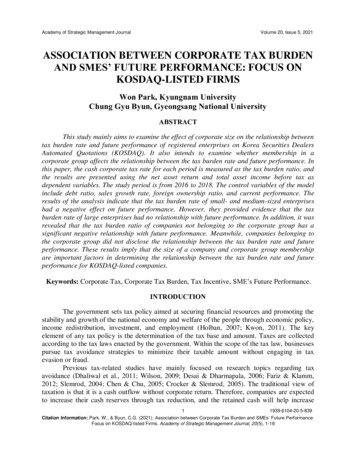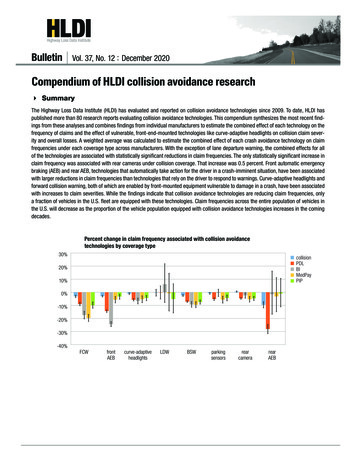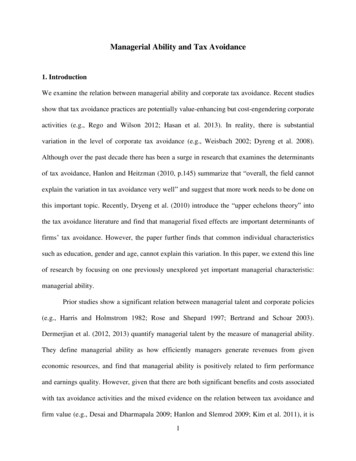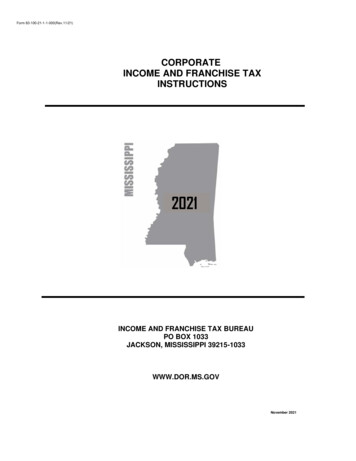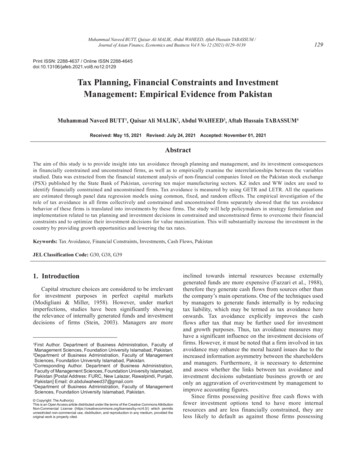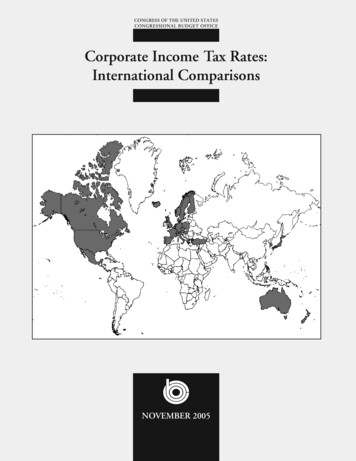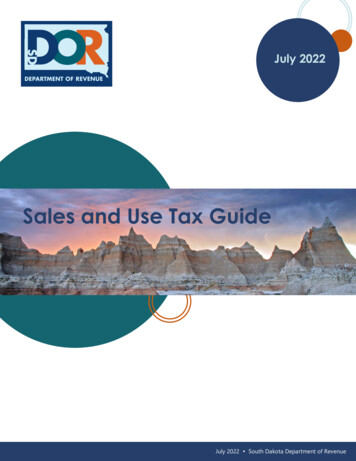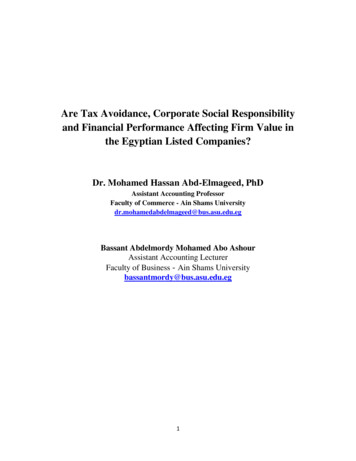
Transcription
Are Tax Avoidance, Corporate Social Responsibilityand Financial Performance Affecting Firm Value inthe Egyptian Listed Companies?Dr. Mohamed Hassan Abd-Elmageed, PhDAssistant Accounting ProfessorFaculty of Commerce - Ain Shams ant Abdelmordy Mohamed Abo AshourAssistant Accounting LecturerFaculty of Business - Ain Shams Universitybassantmordy@bus.asu.edu.eg1
AbstractAlthough previous studies have examined the relationship between taxavoidance and corporate social responsibility, there is no evidence for thisrelationship in emerging economies, including Egypt that characterized by a weakinstitutional, enforcement systems and investor protection and a high level ofcorruption. Therefore, this research examines the relationship between tax avoidanceand the level of corporate social responsibility disclosure and show how both have animpact on the firm value.The topic of this research is rarely investigated in the academic and businessliterature which is whether the level of tax avoidance influences corporate socialresponsibility and in turn firm value. Using a research sample of 36 non-financiallisted firms during the period 2012-2018, the researcher run six multiple regressionmodels to examine the impact of tax avoidance and corporate social responsibility,Tobin’s Q ratio and firm size on firm value using the financial performance as amoderator variable (measured using margin, current ratio, asset turnover, inventoryturnover, profit gross margin, ROE, ROA). The statistical results found that grossprofit margin, return on assets and Tobin’s Q ratio have a positive significant impacton tax avoidance, while current ratio, asset turnover, inventory turnover, return onequity and firm size have a significant negative relationship with tax avoidance. Inaddition findings shows that current ratio and return on equity have a positivesignificant impact on corporate social responsibility, while asset turnover, return onassets, Tobin’s Q ratio and firm size have a significant negative relationship withcorporate social responsibility. Moreover, tax avoidance, corporate responsibilitysocial, Tobin’s Q ratio and firm size found to have a positive significant impact onfirm value.While corporate tax policy is generally considered separate from corporate socialresponsibility policy, tax evasion has greatly affected the social agenda of thecompany and in turns its value. Results indicate that companies involved in taxavoidance strategies are likely to increase corporate social responsibility disclosures.These results are consistent with the legitimacy theory that companies increase ESGdisclosures to alleviate community concerns about low tax payments and buildlegitimacy.Keywords: Tax Avoidance - Corporate Social Responsibility - FinancialPerformance - Firm Value - Egypt2
IntroductionCorporate tax avoidance is conventionally viewed as a tax-reducing devicethat transmits interest from the government to shareholders in order to maximizeshareholders’ value, although an expanding body of work on agency theory assuresthat tax avoidance is closely linked to corporate governance because of the agencycost implications. In practice, the complexity and ambiguity of tax avoidance canprotect managers who engage in different forms of managerial rent extraction such asearnings manipulation and insider transactions which would decrease after-tax cashflows (Desai and Dharmapala, 2009). Enron’s case is a remarkable example. In the1990s, Enron utilized structured financing transactions to evade tax, leading togovernment prosecution and its collapse. Beyond that, firms also want to shoulder thecombined tax avoidance costs, which include direct tax planning, compliance andnon-tax costs. (Lee et al., 2015) proposed that if shareholders can’t fully understandthe cost-benefit calculus, tax avoidance activities could actually minimize firm value.Tax avoidance provides many economic benefits to the firm. By decreasingcorporate income, the management of the firm is trying to reduce the tax burden thatis deposited as expected by shareholders (Armstrong et al., 2015). Tax planningactivities have significantly caught the interest of economists, regulators, accountants,researchers, market analysts, and the investment community about tax avoidanceactivities. However, the adoption of tax planning practices is a debatable issue (Santa,2016). Meanwhile the tax avoidance strategy is also one of the essential managerialdecisions determined by managers (Yee et al, 2018).Corporate social responsibility is a response to social pressures, in relation tothe demands and expectations of stakeholders, environmental concerns, and socialdemands that characterize the dimensions of corporate social responsibility. These arethe most common dimensions of corporate social responsibility that are explicitlymentioned in the definitions of corporate social responsibility. For example, thestakeholder dimension relates to how a company interacts with its employees,suppliers and customers. The environmental dimension refers to how businessoperations are concerned about the natural environment. The social dimension ofcorporate social responsibility relates to how the organization contributes to a bettersociety by integrating its business with social interests (Vicente Lima et al, 2011).Some important corporate social responsibility aspects have been a subject ofresearch, such as its perception, disclosure, and the potential relationship between3
corporate social responsibility and firm performance. Corporate Social Responsibility(CSR) issue relates to a broad spectrum with the relationships between a companyand multiple stakeholders, as well as to the environment. Firm relations with manystakeholders, customers, society in general, and even with shareholders, are part ofthe corporate social responsibility domain.The most widely used definition of corporate social responsibility is the oneproposed in 2001 by Commission of the European Communities which states thatcorporate social responsibility is “A concept whereby companies incorporate socialand environmental concerns into their business operations and in their interactionswith stakeholders on a voluntary basis” (Dahlsrud , 2008).The topic of research is rarely investigated in the business literature which iswhether the corporate social responsibility performance influences the level of taxavoidance (Roman Lanis and Grant Richardson, 2015). While corporate tax policy isgenerally considered separate from corporate social responsibility policy, tax evasionhas greatly affected the social agenda around the world, particularly in the post-globalfinancial crisis environment (Duhigg and Kocieniewski, 2012). Tax evasion would beconsidered by many to be socially irresponsible (Hasseldine and Morris, 2013). Thus,we expect socially responsible companies to be less tax evasion because we view thecorporation as a "real world" entity where CSR is a legitimate business activity andnot just a cost on the road to maximizing shareholder wealth. Our expectations alsoalign with Porter's view (Porter and Kramer, 2006) as follows:The interdependence of businesses and society means that business decisionsand social policies must follow the principle of shared value. That is, the optionsshould benefit both sides. If a company or community pursues policies that benefit itsinterests at the expense of another, it will find itself on a dangerous path. One'stemporary gain will undermine the long-term prosperity of both.Research Aim and QuestionsThe main aim of this research is to how tax avoidance, corporate socialresponsibility and financial performance effects firm value in the Egyptian listedcompanies.1. What is the impact of financial performance on tax avoidance?2. What is the impact of financial performance on corporate social responsibility?3. What is the impact of tax avoidance on firm value?4
4. What is the impact of corporate social responsibility on firm value?5. What is the impact of financial performance on firm value?6. What is the impact of tax avoidance on corporate social responsibility?Literature Review and Hypotheses DevelopmentTax Avoidance and Financial PerformanceTax avoidance is broadly known as the reduction in a firm’s explicit taxliabilities (Dyreng et al., 2008). Under this broad definition, tax avoidance representsa continuum of tax planning strategies where perfectly legal activities are at one endand more aggressive activities would be closer to the other end (Hanlon andHeitzman, 2010). Tax Avoidance is an engineering of “tax affairs” which is stillwithin the framework of taxation provisions. In General taxpayers attempt to paytaxes as small as possible, because paying taxes means decreasing the economicability of taxpayers. Tax avoidance, in the positive sense, can be interpreted as aplanning action in the fulfillment of complete, correct, and timely tax obligations soas to avoid waste of resources. Tax avoidance, in the negative sense, depicts actionsto reduce tax liabilities by utilizing loopholes or shortcomings in the tax regulations.Financial performance can be seen through various financial ratios, such asprofitability ratio and leverage ratio. (Handayani, 2020) utilized return on total assets,current ratio and debt to equity ratio to measure financial performance. Return ontotal assets is a ratio that demonstrates the results (return) of the total assets used inthe company. Current ratio is the ratio to measure the capability of a company to payshort-term liabilities or debt that are due immediately when billed as a whole. Thestudy conducted by (Wiratmoko, 2018) tested the influence of corporate governance,corporate social responsibility, and financial performance on tax avoidance. Thestudy utilized tax avoidance as the dependent variable measured by Cash EffectiveTax Rate (CETR), while commissioners, audit committee, corporate socialresponsibility (CSR), debt ratio, and Return on Assets (ROA) as the independentvariables. This study also utilizes firm size as the control variable. The findings ofthis research indicate that ROA have significant effect on tax avoidance.Based on the previous illustrated literature, the author formed thefollowing hypothesis:H1: Financial performance has significant impact on tax avoidance.5
Corporate Social Responsibility and Financial PerformanceCorporate social responsibility according to (Kusumadilaga, 2010) is amechanism for an organization that voluntarily integrates social and environmentalconcerns into its operations and interaction with stakeholders, which goes beyond theorganization's responsibility in the field of law.In accordance with the international standard ISO 26000 in (Resturiyani ,2012), corporate social responsibility is the responsibility of a firm for the effects ofdecisions and activities on society and the environment at the conference that isachieved in the form of transparent and ethical behavior consistent with sustainabledevelopment and the public good, taking into account the expectations ofstakeholders, in accordance with applicable laws and standards of internationalbehavior, integrated with the organization as a whole.Financial performance is a proxy for the company's ability to utilize its assetsfrom its most important operations to achieve returns. It is the degree to which the setgoal has been accomplished or achieved. Financial performance is a reflection of thecompany's long-term well-being and existence.Previous research has revealed that implementing corporate socialresponsibility (CSR) is believed to improve financial performance. Results of theresearch conducted by (Bidhari et al., 2013) showed that corporate socialresponsibility disclosure affecting financial performance is return on assets (ROA),return on equity (ROE) and net profit margin (NPM). But there are also studies thatshow that there is no positive relationship between corporate social responsibility andfinancial performance. Research by (Yaparto et al., 2013) shows that corporate socialresponsibility does not have a significant impact on return on assets, return on equityand earnings per share (EPS).(Lin et al., 2019) argued that one of the primary reasons why corporate socialresponsibility adds value to a company's performance in the market is the CSRscreening process. A strong CSR company may get higher screening scores andbecome safer when exposed to financial crises or environmental difficulties. Severalstudies show that the intensity of corporate social responsibility screening has asignificant impact on financial performance.(Novrianty Kamatra and Ely Kartikaningdyah, 2015) concluded that theoverall performance of the company is analyzed by analyzing the financialstatements. One of the analytical methods that can be used to evaluate the6
performance of a company is through financial ratio analysis. In the study, the ratiothat will be used to measure financial performance is the profitability ratio.Based on the previous illustrated literature, the author formed the followinghypothesis:H2: Financial performance has significant impact on corporate socialresponsibility.Tax Avoidance and Firm Value(Chen et al., 2014) investigated whether tax avoidance behavior boosts firmvalue in Chinese institutional setting. Several studies conduct their designs on theconsumption that tax avoidance represents wealth transfer from government toenterprises and therefore promotes firm value, using the data of Chinese listedcompanies for the period 2001-2009 and regression model. The results demonstratedthat the rise in tax avoidance tend to decrease the level of firm value.According to (Nugroho and Agustia, 2017), the study has three objectives:First, to investigate the influence of institutional ownership, independentcommissioner on tax avoidance and firm value. Second, to test the effect of taxavoidance on firm value. Third, to examine the effect of institutional ownership,independent commissioner to firm tax avoidance value as intervening variable. Thesample of this study consisted of 92 manufacturing companies listed on theIndonesian Stock Exchange for the period from 2013-2016. Path analysis techniquewas utilized. The results of this study showed that first institutional ownershipsignificantly influence tax avoidance .Second, independent commissioners have noeffect on tax avoidance. Third, institutional ownership doesn’t affect the firm value.Fourth independent commissioner and tax avoidance have significant effect to firmvalue. Fifth tax avoidance doesn’t mediate the institutional ownership relationship tofirm value.Another study conducted by (Handayani, 2020) to determine the influence oftax avoidance and the ratio of the company's financial performance on firm value.The financial performance ratios utilized were Return on Assets (ROA), CurrentRatio (CR), and Debt to Equity Ratio (DER). Cash effective tax rate was utilized tomeasure tax avoidance. Firm value was measured through Price Book Value (PBV).The results showed that ROA and current ratio had a positive impact on firm value,while tax avoidance and debt / equity ratio had no such influence on firm value.Based on the previous illustrated literature, the author formed the followinghypothesis:H3: Tax avoidance has significant impact on firm value.7
Corporate Social Responsibility and Firm ValueAccording to (Yujing Gong et al., 2020) proponents of corporate socialresponsibility suggest that shareholder value can be increased through alignment withstakeholders to enhance customer loyalty and employee satisfaction and produce afavorable corporate image.Corporate Social Responsibility based on argument of (Antonio D'Amato andCamilla Falivena, 2020) may create a good signaling effect and obtain certificationfor its reliability, becoming a form of accreditation for a firm that may providesuperior reliability and reputation. A good reputation can attract capital, goodemployees, and good investors. An outstanding reputation makes the companyattractive to employees who are highly qualified, giving it a competitive advantage.Moreover, increased perceived social responsibility may improve the company'sreputation and allow it to exchange costly explicit claims for less expensive implicitfees. Furthermore, companies involved in corporate social responsibility activitiescan suffer from information asymmetry between managers and investors (Cui, Jo, Na,2018). For instance, disclosure of corporate social responsibility gives investors moreinformation, mitigating agency problems through corporate governance, which willbe reflected in market prices.Based on (Lopatta, Buchholz, and Kaspereit, 2016) companies with highersustainability ratings (known as the dimensions of corporate social responsibility) aremore proactive in disclosing information. Good relationships between CSR firms andtheir direct stakeholders (employees, customers, retailers, producers, and suppliers)can contribute to lower agency costs. According to the study of (Lin et al, 2019)corporate social responsibility includes environmental, social, and governmentalactivities that allow companies to echo the expectations of indirect stakeholders(social communities, charities, legislative organizations, and government) and gaintheir faith and trust.Based on the previous illustrated literature, the author formed the followinghypothesis:H4: Corporate social responsibility has significant impact on firm value.8
Firm Value and Financial PerformanceAccording to (Murni et al., 2018) , the study seeks to determine andinvestigate the effect of Capital Adequacy Ratio (CAR), Loan to Deposit Ratio(LDR), Non-Performing Loan (NPL), Debt to Equity Ratio (DER), and Return onEquity Ratio (ROE) simultaneous and partial to the banking sector in the IndonesiaStock Exchange for the period from 2010-2015. The analytical technique utilized inthis study is quantitative analysis technique. The analytical tool utilized is a classicalassumption test and followed by multiple linear regression analysis. The resultsindicated that capital adequacy ratio has a positive and significant impact on firmvalue, loan to deposit ratio has no significant influence on firm value. Nonperforming loan has a positive and significant influence on firm value, debt to equityratio has negative and significant effect on firm value, and return on equity has noimpact on firm value. Capital adequacy ratio, loan to deposit ratio, non-performingloan, debt to equity ratio, return on equity simultaneously have a significant effect onfirm value.According to the study conducted by( Nawaiseh,2017), the main purpose ofthis paper was to examine the impact of financial performance on the value ofJordanian industrial firms and test which was better to measure the financialperformance, the Tobin’s Q, Gross Profit/Total Assets or Operating expenses/TotalAssets. The sample of the study was 40 firms during the period (2006-2015).Regression was utilized to test the study’s hypotheses. In contrast to previous studieswhich focused on traditional performance measures, this paper takes into account theoperational efficiency indicators and Tobin’s Q index for computing firm’s financialperformance. The results study pointed out that there is a statistically significanteffect of financial performance measured by Tobin’s Q on firm value. In addition,there is a statistically significant effect of financial performance measured by Grossprofit/total Assets on firm value. Also, there is a statistically significant effect offinancial performance measured by operating expenses/total assets on firm value.Based on the previous illustrated literature, the author formed the followinghypothesis:H5: Financial performance has significant impact on firm value.9
Tax Avoidance and Corporate Social ResponsibilityThere are ongoing discussions based on (Prem Sikka, 2010) about themeaning and importance of "tax avoidance" and "tax evasion". In general, taxavoidance is legal and tax evasion is used to describe practices that are against thelaw. However, in practice, the distinction is not entirely clear. Promoters of somestrategies described their plans as "avoiding," but when later examined andchallenged in the courts, they turned out to be "evasive." Sometimes companies haveregulated transactions that have little or no economic substance, but which enablethem to reduce their tax liabilities. On moral and ethical grounds, such schemes weredeemed unacceptable, especially since the loss of tax revenue has a negative impacton the provision of public goods, security, poverty alleviation and social services.In line with current pilot business research (Roman Lanis and GrantRichardson, 2015) defines corporate tax avoidance as the regressive management oftaxable income through tax planning activities. We specifically define a taxavoidance company as one that has a tax dispute involving federal, state, local, ornon-U.S. Government authorities, or have been involved in a controversy over its taxobligations that have raised public concern during the period (MSCI 2012). Hence,tax avoidance may include tax planning activities that are legal or may fall into thegrey area. This distinguishes tax avoidance from tax evasion which only relates toillegal activities.According to the Principles of Responsible Investment (PRI), one of the keyfactors for environmental, social and institutional governance is the payment of a fairshare of taxes (Principles of Responsible Investment (PRI, 2017)). In this regard, itmust be noted that taxation is vital to the personality and the functioning of the state,the economy and society. Tax collection is mainly to enable the government toprovide the public with all types of public goods and services. In Egypt, tax revenuesrepresent approximately 77% of total government revenues and represent about15.8% of GDP (World Bank, 2017). However, tax avoidance can be seen as a valueincreasing activity by companies (Armstrong, 2015). Tax avoidance can be defined asreducing explicit taxes that are paid by companies.There is disagreement about the relationship between corporate socialresponsibility and tax avoidance in the academic literature (Davis et al., 2016). Somestudies dispute and find that socially responsible companies are likely to be less taxaggressive. Based on the stakeholder view, it can be said that paying taxes is a centralcomponent of corporate social responsibility practices (Lin et al., 2017). Using USdata, (Lannis and Richardson, 2015) found that socially responsible firms are lesslikely to be involved in a major tax dispute and controversy over their tax liabilities.10
Likewise, (Hoi et al., 2013) reveal that companies with low CSR activities are moreaggressive in avoiding taxes.Based on the study of (Tarek Abdelfattah and Ahmed Aboud, 2020) he findsthat in contrast, several studies indicate a positive relationship between disclosure ofCSR activities and tax avoidance. Their findings are based on the arguments that acorporation is a contract between shareholders and directors, with one objectivefunction - to maximize shareholder wealth. In such a setting, corporate socialresponsibility imposes a constraint, and this aspect prompts managers to make atrade-off between societal concerns and maximize shareholder wealth. Indeed,managers see lowering taxes or engaging in tax avoidance strategies beneficial toshareholders (Armstrong et al., 2015; Sikka, 2010). Meanwhile, managers expressedconcern about the potential negative impacts associated with undertaking rigorous taxplanning activities, such as penalties, damage to the company’s reputation, publicconcern, and media pressure. As a result, managers tend to increase their CSRdisclosure to cover up adopting tax avoidance strategies or to obtain the expectedbenefits from CSR reports (Hoi et al., 2013; Lin et al., 2017).In line with the above views, Davis et al. (2016) found an alternativerelationship between corporate social responsibility and tax avoidance, indicating thatcompanies involved in tax avoidance strategies are likely to increase corporate socialresponsibility disclosures. These results are consistent with the legitimacy theory thatcompanies increase ESG disclosures to alleviate community concerns about low taxpayments and build legitimacy. Moreover, (Lannis and Richardson, 2013) found thatan aggressive tax company increases corporate social responsibility disclosure toshow that it meets societal expectations regarding its activities.Although previous studies have examined the relationship between taxavoidance and corporate social responsibility, there is no evidence for thisrelationship in emerging economies, including Egypt. Similar to other developingcountries, Egypt is characterized by a weak institutional position (i.e. weakenforcement systems and investor protection) and a high level of corruption (Attia,Lassoud, and Attia, 2016; Maaloul, Chakroun, and Yahyaoui, 2018). Therefore, theresearcher examines the relationship between tax evasion and the level of corporatesocial responsibility disclosure using a dataset that includes ESG ratings.Based on the previous illustrated literature, the author formed the followinghypothesis:H6: Tax avoidance has significant impact on corporate social responsibility.11
Research Conceptual FrameworkIn figure (1), the researcher presents the conceptual framework for the research toshow the relationships between the research independent and dependent variables andhypotheses. The left side shows the tax avoidance and the corporate socialresponsibility (dependent variables in hypotheses H1 and H2 and independentvariables in hypotheses H3 and H4). The right side shows the firm value (dependentvariable) and financial performance as a moderating variable.Figure (1): Research Conceptual FrameworkH3Tax l PerformanceH2H5FirmValueH4Research MethodologyThis research conducted using data from 36 publically listed non-financial companieslisted in the Egyptian stock exchange (EGX) from the year 2012 till 2018. Theresearcher excludes financial firms because of their distinct financial nature.Regression equations are structured to show the relationship between the researchvariables and the data were obtained from the financial statements and the publishedannuals reports.Research Variables and Regression ModelThe statistical relationship between tax avoidance, corporate socialresponsibility and firm value in existence of financial performance as amediating variable was tested using the following five multiple regressionmodels:12
First regression model, used to examine the impact of financial performance ontax avoidanceH1: Financial performance has significant impact on tax avoidance.TAit β0 β1 CRit β2 ATit β3 ITit β4 GPMit β5 ROAit β6 ROEit β7 TQit β8 FSit εitWhere:Dependent variable Tax Avoidance (TA).β0 denotes a constant of the regression equation.β1, β2, β3, β4, β5, β6 denotes regression coefficient of CR, AT, IT, GPM, ROA, ROEdenotes regression coefficient of current ratio, asset turnover, inventory turnover,gross profit margin, return on assets, return on equity as measures for financialperformance (liquidity, efficiency and profitability).β7 and β8 TQ and FS denotes control variables, regression coefficient of Tobin’s Qand firm size.It Firm i in period t.Ti Year fixed effect.εit Standard error term.Second regression model, used to examine the impact of financial performanceon corporate social responsibilityH2: Financial performance has significant impact on corporate socialresponsibility.CSRit β0 β1 CRit β2 ATit β3 ITit β4 GPMit β5 ROAit β6 ROEit β7 TQit β8 FSit εitWhere:Dependent variable Corporate Social Responsibility (CSR).β0 denotes a constant of the regression equation.β1, Β2, Β3, β4, β5, β6 denotes regression coefficient of CR, AT, IT, GPM, ROA, ROEdenotes regression coefficient of current ratio, asset turnover, inventory turnover,gross profit margin, return on assets, return on equity as measures for financialperformance (liquidity, efficiency and profitability).13
β7 and β8 TQ and FS denotes control variables, regression coefficient of Tobin’s Qand firm size.It Firm i in period t.Ti Year fixed effect.εit Standard error term.Third regression model, used to examine the relationship between tax avoidanceand firm value.H3: Tax avoidance has significant impact on firm value.FVit β0 β1 TAit β2 TQit β3 FSit εitWhere:Dependent variable Firm Value (FV).β0 denotes a constant of the regression equation.β1 TA denotes regression coefficient of tax avoidance.β2 and β3 TQ and FS denotes control variables, regression coefficient of Tobin’s Qand firm size.It Firm i in period t.Ti Year fixed effect.εit Standard error term.Fourth regression model, used to examine the relationship between corporatesocial responsibility and firm value.H4: Corporate social responsibility has significant impact on firm value.FVit β0 β1 CSRit β2 TQit β3 FSit εitWhere:Dependent variable Firm Value (FV).β0 denotes a constant of the regression equation.β1 CSR denotes regression coefficient of corporate social responsibility.β2 and β3 TQ and FS denotes control variables, regression coefficient of Tobin’s Qand firm size.It Firm i in period t.Ti Year fixed effect.εit Standard error term.14
Fifth regression model, used to examine the relationship between financialperformance and firm value.H5: Financial performance has significant impact on firm value.FVit β0 β1 CRit β2 ATit β3 ITit β4 GPMit β5 ROAit β6 ROEit β7 TQit β8 FSit εitWhere:Dependent variable Firm Value (FV).β0 denotes a constant of the regression equation.β1, Β2, Β3, β4, β5, β6 denotes regression coefficient of CR, AT, IT, GPM, ROA, ROEdenotes regression coefficient of current ratio, asset t
performance of a company is through financial ratio analysis. In the study, the ratio that will be used to measure financial performance is the profitability ratio. Based on the previous illustrated literature, the author formed the following hypothesis: H 2: Financial performance has significant impact on corporate social responsibility.
